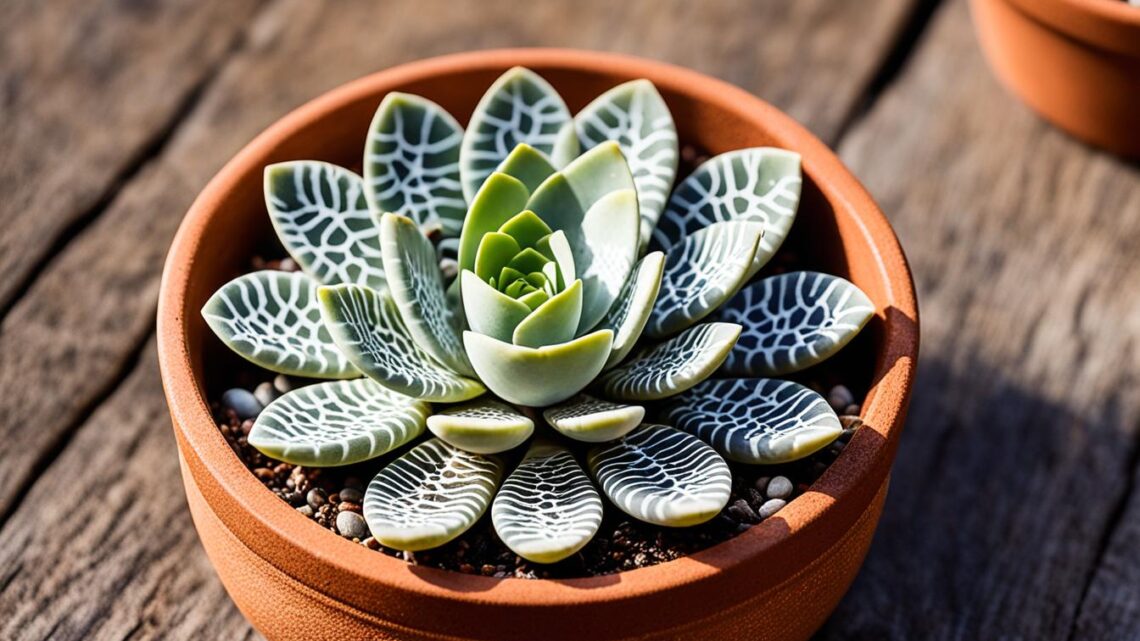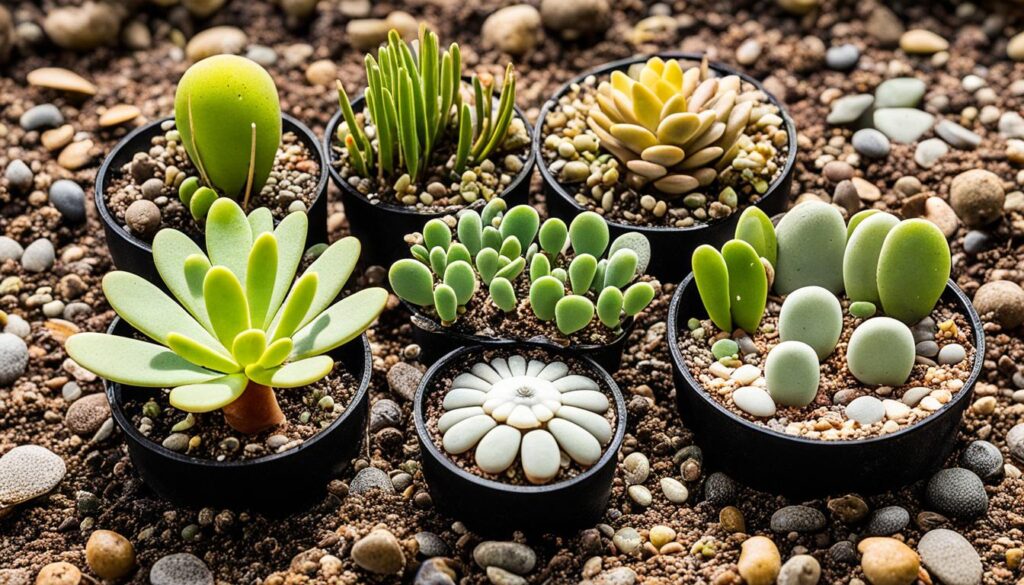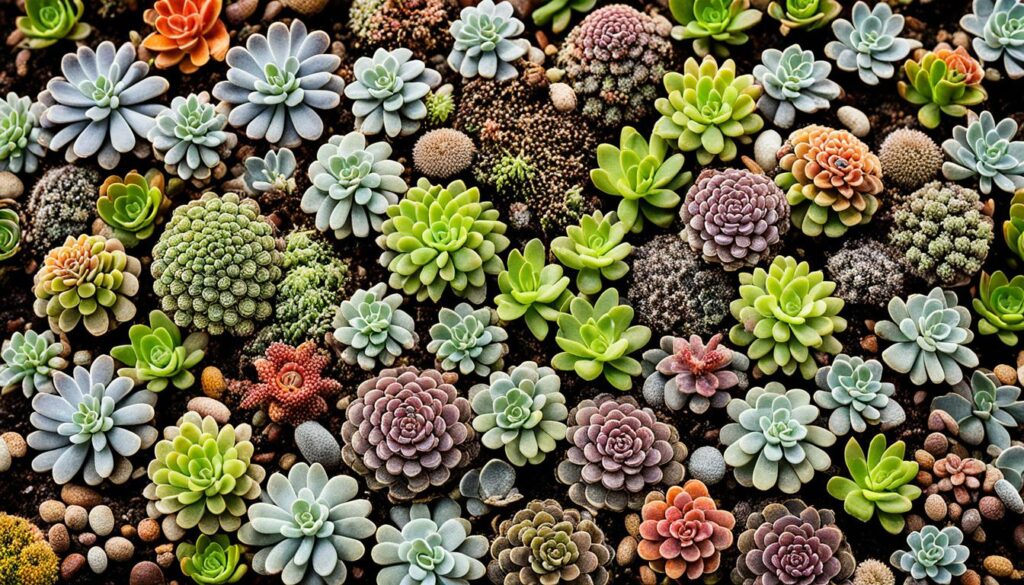
Have you seen a plant that looks so much like its home, it’s hard to tell it apart? That’s exactly how Lithops bromfieldii, the «living stone» succulent, works. It looks just like a rock in the desert landscape of South Africa’s Namaqualand region.
Lithops bromfieldii is a plant that has caught the eyes of many. Its unique look and tough nature make it stand out. Let’s explore more about this special succulent.
What is Lithops bromfieldii?
Description and Origin
Lithops bromfieldii is an eye-catching small plant. It grows very slowly and barely reaches beyond the soil. These plants look like they are made of rubber, with a space between the leaves. They come from the dry, rocky spots of Namaqualand in South Africa. This region is famous for its barren yet beautiful landscapes.
Unique Characteristics
These plants, known as Lithops bromfieldii, looks like rocks and stones. They come in many colors and patterns. This helps them hide where they grow. Their leaves might be gray, green, yellow or brown. Yet, they always have stripes and spots. This makes them hard to spot by animals looking for food. So, they can survive in places without much water.
Lithops bromfieldii belongs to the Mesemb family, also known as the living stones. This family of plants is mostly found in southern Africa. Their unusual looks have made them loved by many people who enjoy plants.
The Fascinating Appearance of Living Stones
Camouflage and Mimicry
Lithops bromfieldii look like rocks with their soft, leafy covers. It’s amazing how they hide in plain sight by looking like stones. This trick keeps them safe from animals that might eat them.
The leaves of Lithops look like the ground where they grow. This makes them very hard to see. It’s like they wear the perfect disguise to survive their tough home.
| Lithops Cultivar | Appearance | Characteristics |
|---|---|---|
| Lithops bromfieldii var. sulphurea C362 | Shades of green, opaque creamy yellow-green, or lime green with tiny darker green blotches on the face | A fast-clumping cultivar capable of producing large mounds with a dozen heads. Known for losing its brown pigment in the leaves. |
| Lithops bromfieldii cultivars | Variations in colors and markings, such as orange, red lines, dark red lines & dots, rusty red, dusky dots with metallic reflex | Display a diverse range of colors and patterns, further enhancing their Lithops appearance and camouflage abilities. |
Lithops are not just cool because they look like stones. People all over the world love them for their unique look. They show us how creative nature can be.
Lithops bromfieldii: Unique Living Stone Succulent
Lithops bromfieldii var. sulphurea comes from South Africa. It’s a unique living stone succulent. Its bright lime green color and leaf tops that look like rocks help it blend right in with its environment. It’s a great choice for anyone who loves succulents, whether you keep them inside or outside.
This plant blooms yellow flowers in the fall. Afterward, its leaves split to show new inner leaves. This process is very special and part of what makes it so interesting to people who enjoy plants.
To grow Lithops bromfieldii well, use deep, narrow pots with good drainage. They should be at least 4 inches deep. The best soil is mostly mineral grit and some organic matter. This mix offers great drainage and helps with nutrients.
Place Lithops bromfieldii where they’ll get plenty of sunlight, like on a sunny windowsill. How you water them is also important. Water in the fall and spring when the leaves show deep wrinkles. But, don’t water in the winter or when they’re splitting. In summer, water sparingly if the top leaves wrinkle a lot.
Lithops bromfieldii is special because of how it looks, its growth, and the care it needs. It’s a must-have for anyone who loves unique succulents. You can enjoy its beauty both indoors and outdoors. Plus, it’s great for beginners and those with more experience in plant care.
Growth Cycle and Dormancy Periods
Lithops bromfieldii has its own way of growing and resting. It has two times of the year when it doesn’t grow much. It’s key to know when these dormancy times are.
In spring, new leaves push through the plant. Meanwhile, the older leaves dry up and fall off. This is when the plant is growing actively. However, when it gets hot and dry in summer, the plant rests. Growth slows down. It also rests in winter, needing only a little water.
Understanding the Lithops growth cycle and its rest times is crucial. This prevents harm to your Lithops. By knowing when your plant sleeps, you help it thrive.
| Growth Phase | Dormancy Period | Watering Requirements |
|---|---|---|
| Spring | Summer | More frequent watering |
| Autumn | Winter | Minimal to no watering |

By understanding the Lithops growth cycle and its rest times, your plants will do well. Giving the right care during each season is the secret. This ensures a healthy and beautiful Lithops bromfieldii.
Caring for Lithops bromfieldii
Watering Requirements
Lithops bromfieldii is different from many plants. It’s a living stone succulent that looks like a small pebble. This plant needs specific care when it comes to watering. Since it comes from places that don’t get much rain, it doesn’t like too much water.
During the winter when it’s not growing much, keep this plant very dry. Then, in spring, you can water it every 10-14 days as new leaves start to show. A little water each time is enough. In summer, when it’s hot and the plant is not as active, water less. But in autumn, when it blooms, you can water more.
Remember, giving too much water is bad for Lithops. It could easily kill it. Following this watering schedule helps prevent overwatering. Research suggests, for a plant in a 5″ pot not getting direct sun, it needs about 0.5 cups of water every 12 days.
Soil and Potting
Creating the right kind of soil for Lithops is important. Use a mix that’s good for cacti and succulents, but add some extra grit. This makes sure the plant is happy and healthy. When planting, choose a deep pot. This lets the plant’s long root grow well. The top of the plant should just peek out of the soil. You can add pretty stones on top for decoration.
Experts advise moving Lithops to a bigger pot when it doubles in size. It’s also good to change its soil every year to keep it nutrient-healthy. Placing the plant close to a sunny, south-facing window is great for its growth.
Types and Varieties of Lithops
The Lithops genus has many interesting living stone types. There are about 37 species, along with subspecies. There are also naturally occurring types and those cultivated by people. These little plants vary in size, from under half an inch to about an inch and a half wide. Each one is unique.
Every Lithops type has special features. These include shape, flower color, and face texture. They may also differ in fissure depth, the presence of windows, and their markings. Some well-known types are Lithops lesliei, Lithops marmorata, Lithops hookeri, Lithops helmutii, Lithops terricolor, and the lovely Lithops bromfieldii.
The Lithops family is full of variety. For example, Lithops localis, aka Lithops terricolor, has lots of dots in grey and purple. There’s also Lithops verruculosa, or Lithops inae. It features small, shiny red pimples. Lithops coleorum is pale creamy brown with pink or green and unique marks. Lithops hookeri has a rusty red-brown look with bright yellow flowers.
Other exciting Lithops types include the ruby red Lithops meyeri and the pinkish-gray to olive green Lithops lesliei with its unique pattern. There’s the brownish-red to bright red Lithops karasmontana. Plus, the grey to green Lithops pseudotruncatella with its marbling stands out.
The Lithops variety is amazing. Each kind has its own charm. This makes them a thrilling find for anyone who loves succulents. Discovering and growing these plants is truly rewarding.

Repotting and Propagating Lithops
It’s key to know the best ways to repot and propagate your Lithops plants. These «living stones» plants don’t need to be repotted often. They are slow growers. They can last a while in the same pot. But sometimes, you might need to repot them. This is usually when they start growing new plants or if they get too big for their pot.
Repotting Techniques
When repotting your Lithops, be careful with their taproot. Make sure the top of the plant just peeks above the soil. For the first three years, keep them in small round pots. Then, move them to slightly bigger square pots. This is where they stay most of the time. They might need an even bigger pot after about 15 years.
Lithops like a special soil mix. It should be one part mineral elements, one part aerated elements, and one part garden soil. The mineral part could be things like gravel or coarse sand. Products like perlite or vermiculite can be part of the mix too. This type of soil helps them grow well.
Lithops Propagation
You can also make more Lithops by seeds or by separating baby plants from the main one. Growing from seeds is fun and also lets you see new varieties. Separating the baby plants lets you grow your collection.
When you’re working on repotting, propagating, or dividing Lithops, remember to be gentle. These plants need careful handling. This way, they will keep looking healthy and beautiful.
Growing Lithops from Seeds
Cultivating Lithops bromfieldii from seed is both fascinating and fulfilling. These plants, known as «living stones,» produce seed capsules after pollination. It takes up to 9 months for these capsules to fully mature. When the capsule is dry but hasn’t opened yet, that’s the time to collect and plant the seeds.
To grow Lithops from seed, you need a soil that drains well. A mix for cacti or succulents is best. Keep the seeds moist until they sprout. This can take a few months. Growing Lithops from seed means your plants might take longer to mature and bloom. But, you’ll get to see different colors and patterns not seen in the parent plants.
Ideal Conditions for Lithops Seed Germination
- Germination Timeframe: From the time the seed is planted until the plant flowers, 3 to 4 years will go by.
- Ideal Temperature: Lithops like day temperatures between 20 – 25°C and night temperatures between 10 and 15°C.
- Germination Duration: It takes about 15 days for Lithops seeds to sprout.
- Recommended Sowing Time: Although you can plant Lithops seeds any time, Autumn (Sept-Oct) and Spring (March-April) are best.
- Fungicide Usage: Use fungicide before you plant the seeds to avoid fungal growth from too much humidity and low temperatures.
Preparing the Potting Mix and Containers
- Choose small plastic pots labeled «cactus» for the seeds. Each pot should be about 5 × 5 cm big and can hold 30 to 50 seeds.
- To lessen the risk of fungus, bake the soil at 150°C for about an hour.
- Sow the Lithops seeds on top of the soil. Don’t cover them with dirt.
It’s critical to keep the right moisture levels during Lithops seed germination. In their first year, these tiny plants need plenty of water. You should spray or water them lightly often. As they grow, they’ll need less care.
With careful care, Lithops seeds may start to sprout in just a short time. If you follow these steps, you’ll enjoy growing your own «living stones» from seed.
Dividing and Separating Offsets
Lithops bromfieldii plants grow offsets around their base as they mature. These young plants, known as «pups,» can be taken from the parent. This is how we make more of these unique stones. The steps for Lithops division are easy and work well.
First, gently remove the entire plant from the soil. Then, use a sharp, clean blade to cut the pups away. It’s important to leave a bit of the root on each new plant. This helps them survive better.
- Gently dig up the entire Lithops plant, including the taproot.
- Use a clean, sharp blade to carefully separate the offsets or pups from the parent plant.
- Ensure each divided offset has a small portion of the root system attached.
- Pot the divided Lithops offsets individually in well-draining soil, taking care to keep the top of the plant just barely visible above the soil surface.
You can make your Lithops collection bigger by propagating from offsets. This also lets you share these special plants. It’s a fun way to see your collection grow and do well.
Outdoor vs Indoor Cultivation
Growing Lithops bromfieldii can happen outside or in. This choice depends on where you live and your local conditions. If you’re in an area without frosty winters, outdoor growth is great. They do best in their natural, rocky world when outdoors. But, if winter gets too cold, below 40-50°F, bring them inside. They thrive indoors in these chilly months.
For indoor Lithops, sunlight is key. They need about 5-6 hours of direct sun every day. And don’t forget to turn them around so they grow evenly. Consider using fluorescent or LED lights indoors. They are cost-effective and meet Lithops’ light needs well.
In zones 10 to 11, Lithops enjoy the summer outside but need some shade. Watching the light levels is critical for their wellbeing. If they stretch out or change color, it might mean they need different light. This goes for inside and outside plants.
It’s crucial to change Lithops’ care by season. Pause winter indoor watering as they sleep through it. Yet, when they start again in late summer, give them a good soak. By spring, you can water more often and tidy up any old leaves. This helps them follow their natural growing cycle.
Deciding to grow Lithops bromfieldii indoors or out means learning about their needs. By focusing on what they require – from light to water – you can make sure they grow well. Doing this allows you to appreciate their exotic look all year.
Collecting and Displaying Living Stones
Lithops bromfieldii, known as living stone succulents, are getting very popular. They are unique and eye-catching. When you collect and display Lithops, mix different colors and patterns. This makes your Lithops displays really interesting.
You can pot Lithops on their own or together in big containers. Their unique looks fit well in many setups. For example, you can put them in rock gardens or on windowsills. The many types of Lithops offer a wide variety for your collections. They come in different shapes, colors, and textures, making your collection diverse.
If you love Lithops or just began collecting, there are many ways to display them. Lithops enhance both indoor and outdoor spaces. They bring nature’s magic into your home. So, they are a great addition for any plant enthusiast.



